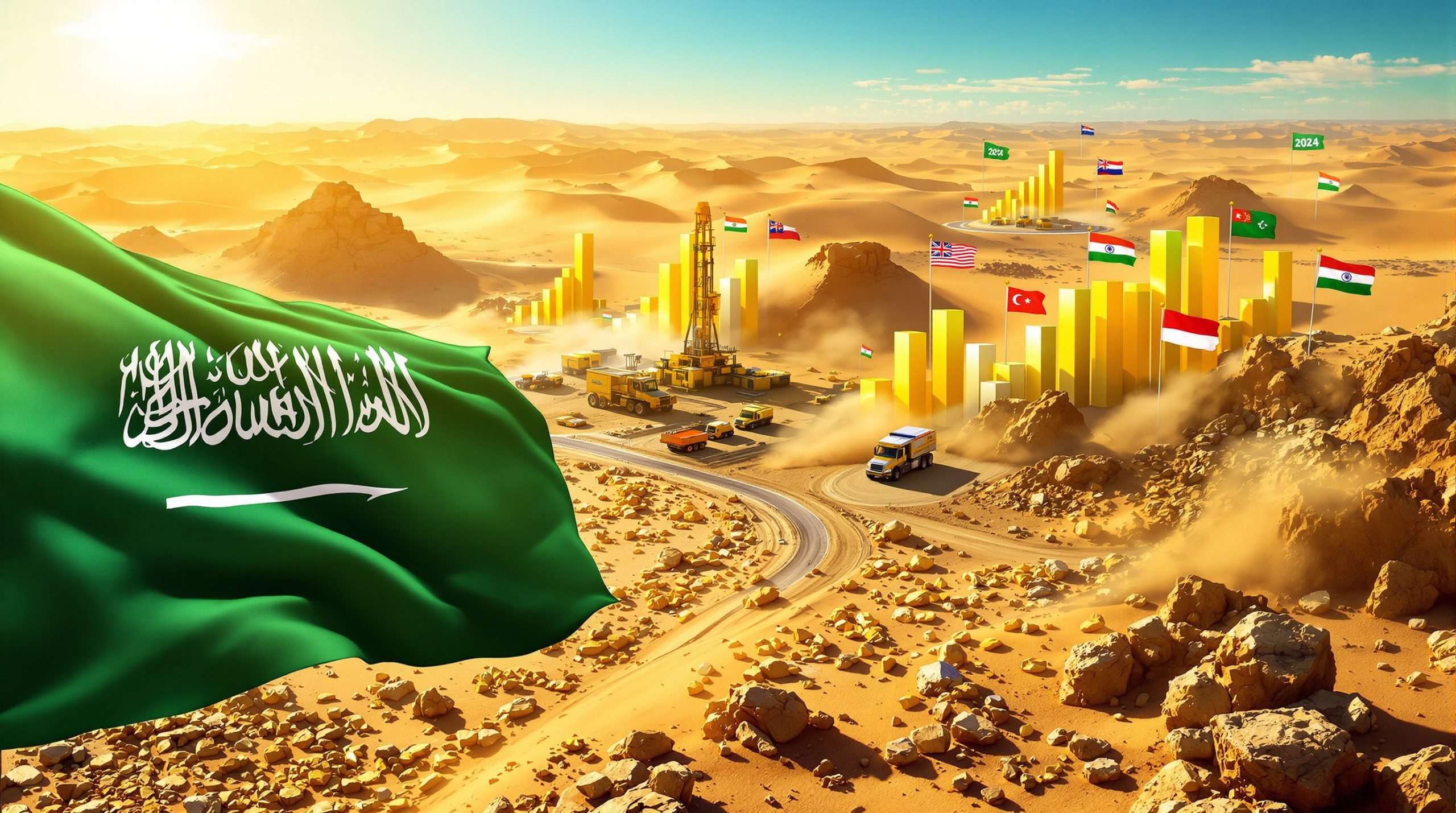Burkina Faso Grants Mining Lease to Russia's Nordgold: Strategic Implications and Economic Impact
In a significant development for West African mining, Burkina Faso has awarded a major gold mining lease to Nordgold, a Russian mining company expanding its footprint in the region. The government approved the mining permit for the Niou gold deposit, covering 52.8 square kilometers in Kourweogo province. This strategic move comes amid shifting geopolitical alliances and record gold prices, positioning both the country and the Russian miner for potential economic gains.
The mining lease reflects Burkina Faso's continued reliance on gold as a critical economic driver while also signaling strengthening ties with Russia following the country's 2022 military takeover. With gold prices surging 25% in 2025 to over $3,350 per ounce, the timing could prove particularly advantageous for both parties involved. Investors interested in understanding the broader impact should consider a comprehensive mining stocks guide to evaluate potential opportunities.
Understanding Nordgold's New Mining Lease in Burkina Faso
The recently approved Niou gold deposit mining permit covers a substantial 52.8 square kilometers in Burkina Faso's Kourweogo province. Under the agreement, Jilbey Burkina, a subsidiary of Russia's Nordgold, maintains an 85% ownership stake, while the Burkinabe government holds the remaining 15% equity without financial contribution, in compliance with the country's 2023 mining code.
This new project complements Nordgold's existing operations in the country, where the company already operates the Bissa and Bouly mines. These existing facilities have been significant contributors to Burkina Faso's gold production, with approximately 10 tons of gold produced in 2023 according to data from Swissaid.
The Niou deposit represents a valuable addition to Nordgold's portfolio, with projected yields of 20.22 metric tons of gold over an 8-year mine lifetime. This expansion is particularly significant as Nordgold looks to secure stable production following its 2019 acquisition of Jilbey Burkina for $35 million.
Geospatial analysis reveals additional complexity, as the Kourweogo province currently supports substantial artisanal mining activity covering approximately 12% of the region. This presents both challenges and opportunities for the formalized mining operation, as Nordgold will need to navigate relationships with local informal miners while implementing industrial-scale extraction.
What Are the Economic Benefits for Burkina Faso?
The Niou mining project promises substantial contributions to Burkina Faso's economy, with projections indicating 51.5 billion CFA francs (approximately $89 million) flowing directly to the state budget over the mine's lifespan. Additionally, 7.06 billion CFA francs (about $12.3 million) will be directed to the state's mineral wealth fund, strengthening the country's financial reserves.
Employment generation represents another crucial economic benefit, with 204 direct jobs expected to be created. The ripple effect of these positions, combined with supporting continued employment at the nearby Bissa Gold SA mine, could result in an additional 300 indirect roles within the local economy.
According to Burkina Faso's Finance Ministry, mining currently constitutes approximately 15% of the country's GDP, with gold exports covering roughly 75% of foreign reserves. Under the country's 2024 fiscal policy, revenue from mining operations is strategically allocated, with 60% directed toward security initiatives and 30% toward infrastructure development.
The timing of this mining lease coincides with a remarkable surge in gold prices, which have increased by 25% in 2025 to reach $3,351 per ounce. This price environment significantly enhances the project's economic viability and potential returns for both Nordgold and the Burkinabe government. Understanding the broader gold market analysis helps contextualize how these developments fit within global trends.
Local economic development stands to benefit from Nordgold's commitment to regional procurement. In 2023, the company implemented a $20 million local supplier program, creating additional economic opportunities beyond direct employment at the mine site.
How Does This Deal Reflect Shifting Geopolitical Alignments?
The Niou mining lease represents more than just an economic transaction—it symbolizes Burkina Faso's ongoing pivot from Western allies toward Russia following the 2022 military takeover. This realignment has been characterized by increased Russian investment, with reports indicating approximately $200 million flowing into mining and security sectors since the coup.
"Burkina Faso's pivot to Russia aims to counter jihadist threats and Western sanctions," notes a recent Institute for Security Studies report, highlighting the dual motivations driving this geopolitical shift. The mining sector has become a key battleground in this changing landscape, with Western companies like IAMGOLD reducing their Burkina Faso holdings by 40% in 2023.
Russia's economic influence in West Africa has been expanding through various channels, including the controversial Wagner Group, which has reportedly secured three mining sites in exchange for a 20% revenue share. This pattern of resource-for-security arrangements mirrors similar deals in neighboring countries, such as Mali's 2022 agreement with Rosatom for uranium mining.
The changing power dynamics extend beyond just Russian and Western interests. China has also established a significant presence in Burkina Faso's resource sector, with Sinohydro negotiating a $1 billion infrastructure-for-minerals deal that further complicates the country's international relationships.
For Russia, securing mining assets in gold-rich Burkina Faso represents a strategic economic win amid international sanctions and provides a foothold for expanding influence throughout the region. Meanwhile, for Burkina Faso's military leadership, Russian partnerships offer alternatives to Western aid that often comes with governance and human rights conditions. Investors need to consider these geopolitical investor strategies when evaluating opportunities in politically complex regions.
What Challenges Could Impact the Mining Project?
Despite promising economic projections, the Niou mining project faces substantial challenges that could impact its development timeline and long-term viability. Security concerns top the list, with data from the Armed Conflict Location & Event Data Project (ACLED) showing 487 attacks in 2024—a troubling 22% year-over-year increase in violent incidents linked to Islamist militant activity that began in 2015.
Social factors present another significant hurdle, particularly the displacement of artisanal miners. An estimated 15,000 small-scale miners currently operate within the Niou concession area, according to the Burkina Faso Mining Ministry. This displacement has measurable community impacts, with a local NGO reporting that "Nordgold's fence-line communities report losing 70% of income due to land restrictions."
Regulatory considerations under Burkina Faso's new mining code add additional complexity. The 2023 revision requires mining companies to allocate 1% of revenue to community development programs—a positive step for local communities but an additional operational cost for Nordgold. Similar requirements have led to tensions elsewhere, as evidenced by Endeavour Mining's 2023 clashes with artisanal miners in Houndé.
Environmental and climate challenges further complicate the operating landscape. UNEP data indicates that Sahel droughts have reduced water availability for mining operations by 30%, an increasingly critical factor in water-intensive gold extraction processes. Managing this resource constraint while maintaining production targets will require sophisticated water management strategies.
Budget constraints facing the Burkinabe government could also impact the project's development timeline. With limited fiscal resources stretched between security initiatives and public services, the government's ability to fulfill its obligations as a 15% stakeholder may face periodic challenges.
Burkina Faso's Gold Mining Sector: Current Landscape
Burkina Faso has established itself as a significant gold producer on the African continent, with output reaching over 57 tons in 2023 according to the World Gold Council. This production volume ranks the country fourth among African gold producers, behind Ghana, South Africa, and Mali.
The sector's landscape features several major international mining companies. IAMGOLD produced approximately 12 tons, while Endeavour Mining contributed 18 tons, and Nordgold's existing operations yielded 10 tons in 2023, according to Swissaid data. These formal operations represent only part of the picture, however, as the informal sector produces an estimated 45 tons annually, with much of this production smuggled through neighboring countries, particularly Togo.
"We aim to double formal production by 2030 via FDI," stated Burkina Faso's Mining Minister in a recent policy announcement, highlighting the government's ambitious growth targets despite ongoing security challenges. This goal stands in contrast to neighboring Ghana's more mature gold sector, which produced 130 tons in 2023 with approximately 90% of operations formalized.
The mining sector's economic contribution is substantial but comes with governance challenges. The Tax Justice Network estimates that approximately $300 million in potential tax revenue is lost annually due to transfer pricing and other tax avoidance strategies employed by international mining companies operating in the country.
Political instability has undeniably impacted mining operations, with several companies reporting production disruptions due to security incidents. However, the high-grade nature of many Burkinabe gold deposits (averaging 2.5 g/ton compared to the global average of 1.6 g/ton) continues to attract investment despite these challenges, as the favorable geology offers compelling economic returns even with elevated operational risks.
How Does the Gold Price Surge Affect Mining Investment?
Gold has experienced a remarkable price surge in 2025, appreciating by 25% and reaching historic highs above $3,350 per ounce. This price environment creates significant tailwinds for the Niou project and broader mining investment in West Africa. US tariffs on Chinese technology have been a key driver, contributing to a 15% increase in gold demand as investors seek safe-haven assets amid rising global tensions.
"Gold could hit $4,000/oz if US-China tensions escalate," forecasts Goldman Sachs in their recent commodity report, highlighting the potential for further price appreciation. This bullish outlook dramatically improves profitability projections for the Niou project, where production costs benefit from West Africa's favorable economics. According to S&P Global, the all-in sustaining cost (AISC) for West African mines averages $1,200 per ounce compared to the global average of $1,400.
Nordgold has implemented sophisticated financial strategies to capitalize on the favorable price environment while managing volatility risk. The company has reportedly pre-sold 60% of its 2025 output at $3,200 per ounce, securing strong profit margins while maintaining upside exposure on the remaining production.
The gold price surge has lifted profits across the region, with Barrick's Kibali mine in the Democratic Republic of Congo reporting a 35% profit increase in the first quarter of 2025. This improved financial performance has accelerated investment decisions across West Africa's gold belt, with capital expenditure on new projects rising 40% year-over-year.
An often-overlooked factor affecting gold investments is the recycling market. The World Gold Council reports that 1,200 tons of gold were recycled globally in 2024, potentially moderating long-term price increases as higher prices incentivize increased recycling activity. However, analysts project that structural supply constraints from traditional mining will limit recycling's impact on price trends through 2027. Investors seeking to capitalize on these trends might benefit from exploring various gold ETF strategies as a lower-risk entry point into the market.
FAQ: Nordgold's Mining Lease in Burkina Faso
When will the Niou gold mine begin production?
Production at the Niou gold mine is expected to commence in late 2026, following approximately 18 months of development work. This timeline allows for necessary infrastructure construction, including processing facilities, access roads, and water management systems. Several factors could influence this schedule, including seasonal weather patterns that limit construction activities during the June-September rainy season, potential security incidents requiring operational pauses, and supply chain disruptions affecting equipment delivery.
How does this mining lease compare to other recent deals in West Africa?
The Niou mining lease features similar terms to recent agreements in neighboring countries, with the 85/15 ownership split between Nordgold and the government reflecting regional standards. However, the $89 million projected government revenue is somewhat lower than the $120 million secured by Ghana in its 2023 agreement with Gold Fields for the Damang extension. Notably, Burkina Faso's revised mining code provides less favorable terms than Ghana or Côte d'Ivoire but offers better stability guarantees than Mali's frequently revised regulatory framework.
What is Burkina Faso's overall gold production capacity?
Burkina Faso produced 57 tons of gold in 2023, placing it fourth among African gold producers. The country's mining ministry projects potential output could reach 80 tons annually by 2028 if security conditions improve and planned investments materialize. Currently, Burkina Faso ranks 13th globally in gold production, with considerable untapped potential in its Birimian greenstone belt, which shares geological characteristics with Ghana's prolific gold fields. Analysts tracking the gold market outlook 2025 suggest this production growth could significantly impact regional supply dynamics.
How might local communities be affected by the Niou mining project?
The Niou mining project will significantly impact local communities, with mixed outcomes likely. Approximately 15,000 artisanal miners currently operating in the concession area face displacement, potentially losing crucial income sources. However, Burkina Faso's 2023 mining code requires 1% of revenue allocation to community development initiatives, which should fund infrastructure improvements like schools, healthcare facilities, and water access projects. Environmental impacts remain a concern, particularly regarding water usage and potential contamination, though Nordgold has committed to implementing international environmental management standards.
Ready to Capitalise on the Next Major Gold Discovery?
Stay ahead of gold market opportunities with Discovery Alert's proprietary Discovery IQ model, delivering real-time notifications on significant ASX mineral discoveries and transforming complex data into actionable insights. Explore our dedicated discoveries page to understand how major mineral finds can generate substantial returns for early investors.




